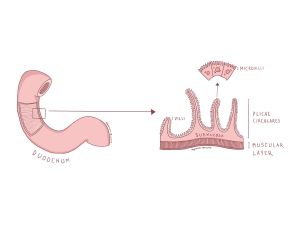9 Duodenum
Small Intestine
After food exits the stomach it enters the hose-like organ known as the small intestine. The small intestine which is directly distal of the stomach separated with pyloric sphincter can be divided into 3 sections each with their unique features and histology: the duodenum, jejunum, and ileum.

Figure 12 Anterior view of the small intestine
Duodenum
Lets start with the first and smallest segment known as the C-shaped duodenum which is roughly the first 25-40cm of the small intestine responsible for receiving the stomach’s content and integrating several digestive enzymes.

Figure 13 Anterior view of the duodenum and gall bladder
The duodenum has several identifiable characteristics. For instance, the plicae circulares are folds within the lumen (interior) of the duodenum which increase the surface area for absorption and mixing.
With regards to the function of the duodenum, it first receives chyme from the stomach and mixes in several digestive enzymes from the pancreas, liver and gallbladder. These enzymes flow from the duodenal papilla to break down big food particles into delicious nutrients. The small intestine is paramount in absorption of nutrients which is why it is equipped with finger-like projections on its surface called villi. Even more, each villi is covered in even smaller finger like projections known as microvilli:

Figure 14 Small intestine and zoom in of villi and microvilli
The duodenum is also laced with Brunner’s glands which secrete bicarbonate rich mucus to help diffuse the acidic chyme from the stomach. This very basic (opposite of acidic) acts like a fire extinguisher so the rest of the small intestine is not corroded by the acidic chyme.
Check out this meme!

Hint: The duodenum, the first segment of the small intestine, is covered in villi! Villi are small projections that maximize the surface area within the small intestine for nutrient absorption. This meme refers to a pun as ‘villi’ and ‘really’ sound very similar!

